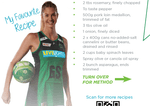How to keep on track with (and keep track of) your exercise resolution
by Peter Edwards,
- January 5, 2020
- Leave a comment
On the 1st of January, many of us resolved to eat better and/or exercise more, but we don't always find ourselves following through. Exercise in particular, is about the long-game. That is, the long-term benefits (lower risk of cancer, heart disease, type 2 diabetes and chronic musculoskeletal injuries) are so powerful and important, that it’s almost a no-brainer.
Unfortunately, humans are short-term thinkers and when we don’t see immediate benefits, we lose interest. So how do we keep going? Here's our hot tips to keep on track this year.
1. Make your activity enjoyable
Sticking to an exercise plan can be challenging. Find an activity that
- You find enjoyable
- Gets you out socialising
- Allows you to de-stress or
- Allows you to build competence.
Research shows that exercise that does any of these things is easier to maintain than exercise done with the goal of improving appearance or losing weight alone.

2. Monitor your progress
Traditionally, people tend to measure the effectiveness of their exercise program by using a set of bathroom scales and a tape measure. While there is some merit in using these to assess body composition and weight changes, they don’t fully depict any improvements in fitness.
One way to assess your fitness and keep accountable, is to time yourself on a brisk walk or run.
If you're just starting out, time yourself over a set distance as a baseline. Then every fortnight or month, time yourself over the same distance. A quicker time generally indicates better aerobic fitness, and a longer time suggests room for improvement! Use this as motivation to keep up with your program, and to keep improving!

3. Experiment
If exercise is a new thing for you, approach it with curiosity and focus on discovering what works for you! Try out different times and days when you can make it to the gym, or different pieces of gym equipment, or where you like going for your walk, and who with (if anyone). From there, you can focus on the process of learning how to be active, like learning how to pace yourself if you go for a walk or run, and knowing, by listening and self-regulating your breathing with the Talk Test!
4. The Talk Test
Generally speaking, the greater the intensity you exercise at, the fitter you will get. But how do you keep track of the intensity? While there are many popular devices which can track how hard you are exercising (smart phones, watches and heart rate monitors), the most reliable and portable (not to mention cheap!) method is your breath, known as the Talk Test.
The Talk Test works on the principle that the harder you exercise, the more oxygen your cells will need, and the more oxygen you need to suck in through your nose and mouth. This affects your ability to talk or sing. So as your exercise intensity increases, the pace of your breath (which increases with your oxygen use) will begin to quicken and deepen, impacting your ability to talk.
Exercising at a moderate to vigorous intensity will help develop your ability to use oxygen efficiently, benefitting your overall health and fitness. This is a good way to keep tabs on how much fitter you are getting during certain tasks. For example, are you less out-of-breath after doing 10 squats, or climbing the stairs in the carpark?
All the best with your active goals this year!





